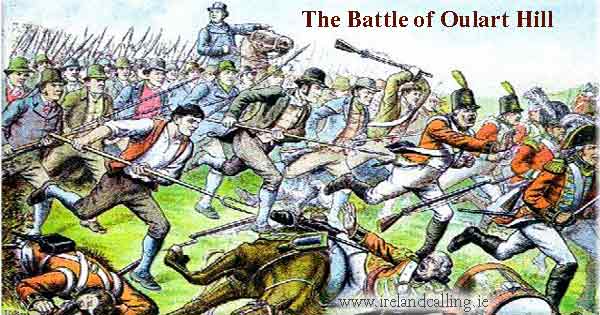may-top.html
1798 The Battle of Oulart Hill took place on this day in 1798. It was one of the most significant victories for the United Irishmen during their failed rebellion. The rebels in Wexford were still waiting for the signal from Dublin that the rebellion had begun.
This fact caused great tension in the town, as the few British soldiers present were actively hunting and slaying any known rebels. This resulted in large congregations of people, both rebels and civilians, with the idea that there was safety in numbers.
The previous night, a group of around 100 rebels encountered a 20 strong party of British soldiers. The soldiers were visiting a house of a suspected rebel, but when they couldn’t find him there, they burnt down the house.
As they passed the group of rebels again on their return, scuffles broke out and two of the British soldiers were killed. Heavily outnumbered, the rest fled.
The next day both sides had gathered heavy reinforcements. A party of up to 1,000 rebels camped on the top of Oulart Hill, in the rural area outside Wexford. A troop of 100 British soldiers approached the hill and started burning nearby buildings in an attempt to lure the rebels down from their superior position.
The soldiers also opened fire on the rebels but were too far to land any significant shots. Still, this show of force intimidated some of the rebels, which included women and children. Those unwilling to fight began to try and escape but were pinned on the hill by the soldiers.
A wave of confidence surged through the British troops, upon this apparent show of weakness by their enemy. They charged up the hill to attack.
Unbeknownst to them, the rebels had set up two ambushes halfway up the hill. Rebels armed with guns and pikes attacked the soldiers once they came into range, completely surprising and overwhelming them.
The rest of the rebels charged down the hill and killed any survivors, of which there were very few. The rebels lost only six men in the battle compared to more than a hundred British soldiers.
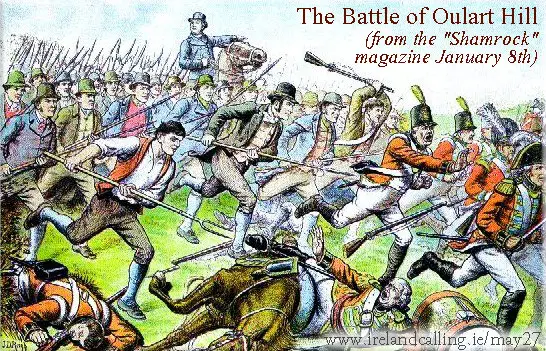
Discover more about the history of 1798 Rebellion
* * *
1857 Joseph Brenan died in New Orleans on this day in 1857. He was a gifted writer and poet from Cork. He became involved in the Young Irelanders movement in the mid-19th century and moved to Dublin to be near its headquarters.
Brenan took part in the Young Irelanders Rebellion in 1848. However, his talents were in writing, not as a soldier. He wrote in the United Irishmen publication and inspired the rebels with his words.
He was arrested and spent several years in prison, where he wrote some of his most famous poems. ‘Come to me, dearest’ and ‘Yearning’ were two, which were love letters to Mary, the sister of his Young Irelander comrade John Savage.
After his release from prison he continued to write to try and rally the nationalist spirit in the country. However, the British had responded to the rebels with heavy military action, and the people of Ireland were suffering greatly from starvation and disease due to a successive period of failed crops that became known as the ‘Great Famine’.
Brenan had to flee to America after his publications sparked another warrant for his arrest. He moved to New Orleans and married his sweetheart Mary Savage. The two had a large family but tragically, Brenan didn’t live to see his children grow up. He died in 1857 from illness, aged just 29.
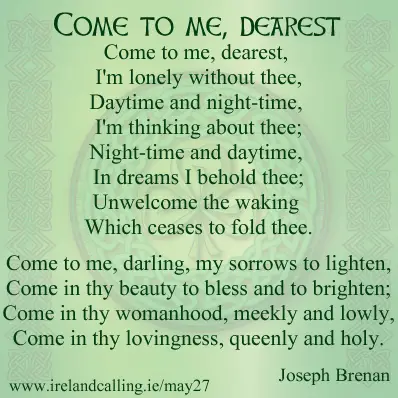
See the whole poem Come to me Dearest here
* * *
1881 Thomas Traynor was born on this day in Dublin in 1881. He was an Irish nationalist and fought with the rebels during the Easter Rising in 1916.
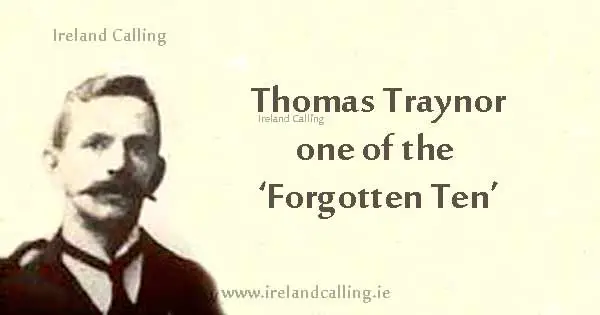
He also fought in the Irish War of Independence in 1921. Traynor was captured during an Irish Republican Army ambush on a group of British troops. Two members of the Royal Irish Constabulary were killed in the attack and Traynor was sentenced to death for his part.
He is one member of the ‘Forgotten Ten’, who were men captured and executed by the British authorities during the Irish War of Independence.
* * *
1966 A Catholic civilian was shot dead by members of the Ulster Volunteer Force on this day in 1966. John Scallion was an innocent civilian in the wrong place at the wrong time in Belfast.
The UVF had issued the following statement a week earlier:
“From this day, we declare war against the Irish Republican Army and its splinter groups. Known IRA men will be executed mercilessly and without hesitation. Less extreme measures will be taken against anyone sheltering or helping them, but if they persist in giving them aid, then more extreme methods will be adopted.
“We solemnly warn the authorities to make no more speeches of appeasement. We are heavily armed Protestants dedicated to this cause.”
Gusty Spence, a UVF commander, had sent out four of his men with the order to kill IRA member Leo Martin. They couldn’t find Martin and so shot the first Catholic they could find. That Catholic was 28-year-ol John Scallion, who died in hospital from his injuries.
Spence later wrote about the attitude of himself and his fellow UVF members:
“At the time, the attitude was that if you couldn’t get an IRA man you should shoot a Taig, he’s your last resort”.
Taíg is a derogatory term for a Catholic. It was frequently used by members of the Ulster Volunteer Force during the ‘Troubles’ of the 1960s, 70s and 80s.
* * *
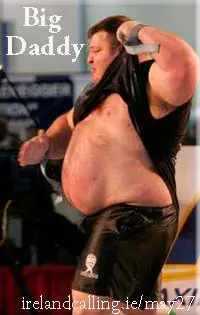 1971 Happy birthday to ‘The Daddy’ Glenn Ross, born on this day in County Down in 1971. He was crowned Britain’s Strongest Man three years in a row from 1999-2001, and then won the newly formed competition UK’s Strongest Man five times in 2004, 2006, 2007, 2008 and 2010.
1971 Happy birthday to ‘The Daddy’ Glenn Ross, born on this day in County Down in 1971. He was crowned Britain’s Strongest Man three years in a row from 1999-2001, and then won the newly formed competition UK’s Strongest Man five times in 2004, 2006, 2007, 2008 and 2010.
Ross is a much loved character within the power sport. He has made guest appearances on numerous television shows, and is always willing to take a joke and laugh at himself.
He has had to endure gruelling challenges during competitions. He has competed in the World’s Strongest Man competition on five occasions.
Ross lifted three cars with the rear wheels completely off the ground in 2003. The total weight was almost 3 tonnes, although the method of lifting the cars involved a set of levers lifting one side of the car and the competitors lifting the other side. With this in mind, Ross lifted around 400kg in weight, which is still more than most of us do in the gym.
* * *
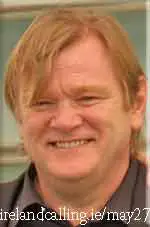 1998 Dublin-born actor Brendan Gleeson spoke publicly on this day in 1998 to defend himself against criticism he had received for his latest film role. Gleeson was playing violent gangster Martin Cahill, in the £6m film The General.
1998 Dublin-born actor Brendan Gleeson spoke publicly on this day in 1998 to defend himself against criticism he had received for his latest film role. Gleeson was playing violent gangster Martin Cahill, in the £6m film The General.
Many criticised the film for portraying Cahill as a modern-day Robin Hood, who protected people in his community and only committed crimes against the rich. This was not a true portrayal of Cahill, who was a violent thug who had committed terrible acts throughout his life.
The film and its production won several awards, including John Boorman being named Best Director at the 1998 Cannes Film Festival.
Gleeson has starred as other controversial figures from history in his career. eg Winston Churchill and Michael Collins.
Click here to read about more Irish actors
may-bottom.html
